Chapati Recipe (Indian Flatbread)
Updated: September 9, 2023, By Swasthi
Chapati Recipe with tips & tricks to make them perfect & super soft every time! There is nothing better than a freshly made flatbread. With the freshest flavor and perfect texture, these homemade Chapati are the absolute best! Once you master the technique of making soft Chapati, you will never buy them from the stores. Serve them with dal, curries, stew or use them to make wraps, rolls, quesadillas, kothu roti or chapati noodles.
About Chapati
Chapati is a traditional unleavened Indian flatbread made with just 3 ingredients – whole wheat flour, ghee/oil & water. Optionally a little salt is added.
The term Chapati has been derived from the Hindi word “Chapat” meaning “slap” or “flat” which describes the traditional method of shaping chapati by slapping the dough in between the palms. (Source: Wikipedia). Later rolling pin has over taken this method of slapping the dough.
Though Chapati is made with the same ingredients as Roti, both are actually not the same.
Chapati Vs Roti
Roti also known as phulka is essentially puffed and is cooked without any fats like ghee or oil. Sometimes it is also cooked on a direct flame to help it puff. Once it is off the heat, ghee is smeared. Where as a chapati may or may not puff & is always cooked with fats on a tawa. It is never cooked on a direct flame.
Roti is never layered but chapati is sometimes layered. In Maharashtra and some parts of Karnataka a chapati is layered similar to Plain Paratha, but made with lesser Ghee or oil. In a few other countries, a flatbread inspired by Indian chapati and lachha paratha is made using a pleating technique.
These are actually called parotta in India and I have show such recipes in this Chicken Kathi Roll and Paneer Kathi Roll post (with wheat flour). There are many kinds of roti and this Tandoori Roti is one of them.
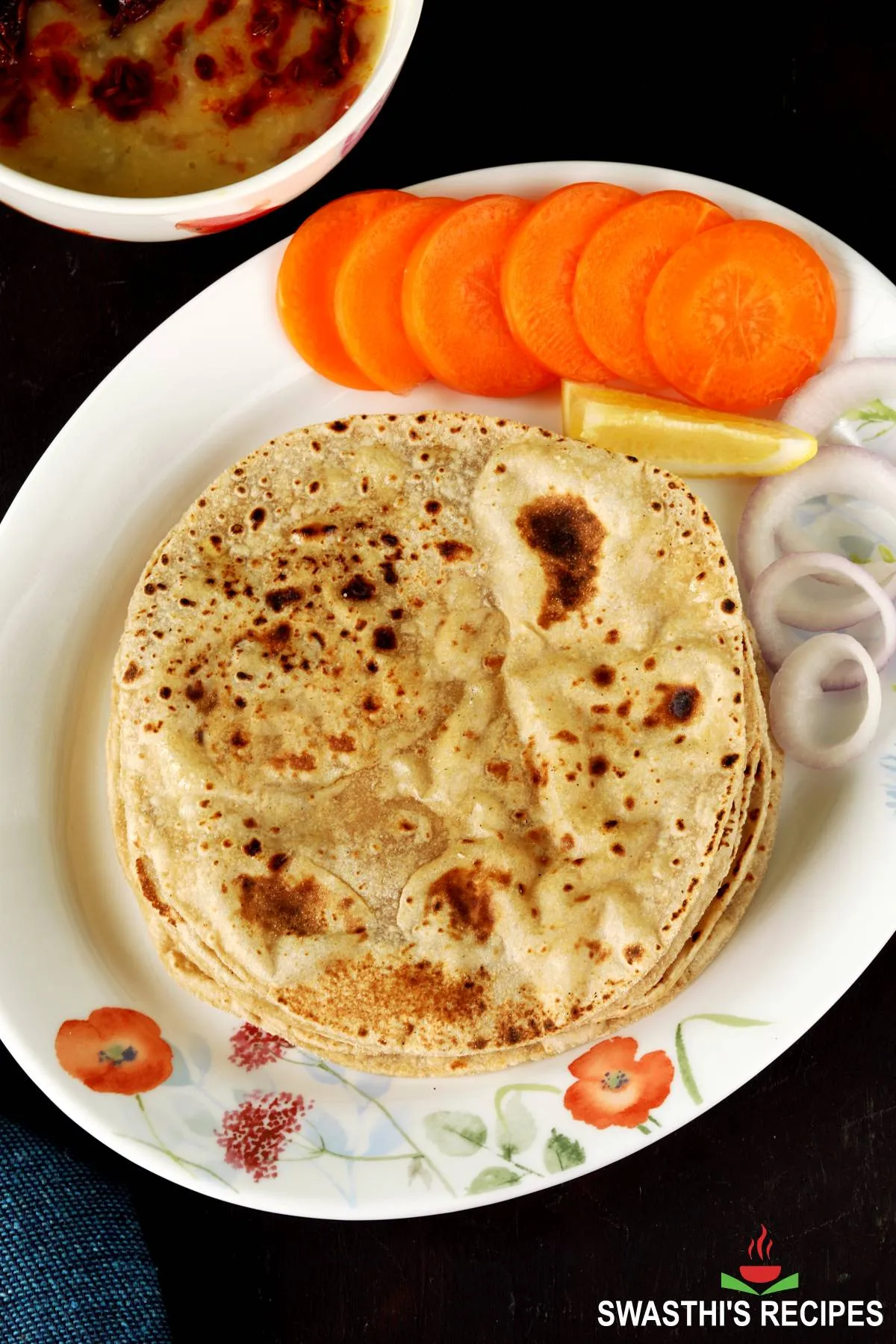
If you have grown up or lived in South India or Western Indian states, you will find that the terms ‘Chapati’ and ‘Roti’ are not used interchangeably. We understand a Chapati means cooked on tawa with oil or ghee, while roti means puffed & cooked on dry heat without fats.
For the same reasons, the flavor of Chapati is very different from Roti/ Phulka.
Roti is always round but a chapati can be round, triangle or even in between these two. Though the process of making the dough for both Chapati and Roti is same, some people use milk or Indian buttermilk in place of water to knead the dough.
Again Chapati means different to different people. It depends on where you have grown up or what is made as chapati in your family. A lot of people shape the dough to single layer while many make layered chapati.
In this post I share both the methods of rolling, with step by step photos.
Here are some curries that go well with chapati
Tofu Curry
Vegetable Curry
Chickpea Curry
Black Eyed Peas Curry
Photo Guide
How to Make Chapati (Stepwise Photos)
Make Dough
1. Add 2 cups whole wheat flour to a wide mixing bowl. Make a well in the center. Usually chapati is not salted but if you want you may add ¼ teaspoon salt and 1 to 1½ tablespoon oil (optional). Pour ¾ cup warm or hot water. I use hot water, not boiling hot. (read my pro tips section below)
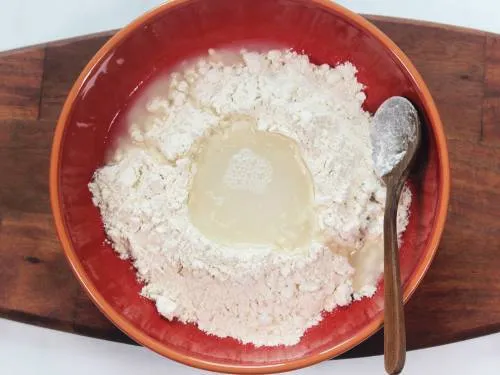
2. Begin to mix to form a soft dough. If using hot water use a spoon to mix first, later use your fingers. If the dough is too dry, splash a bit of warm water and form the dough. Do not make it sticky.
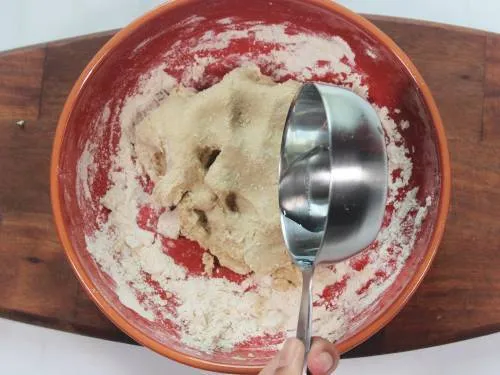
3. Knead for a minute or 2. Smoothen the dough with your palm. It should be soft, not tight & dent easily when you poke with your finger. Smear some water all over the dough. Cover and rest for a minimum of 30 minutes. (read pro tips section below)
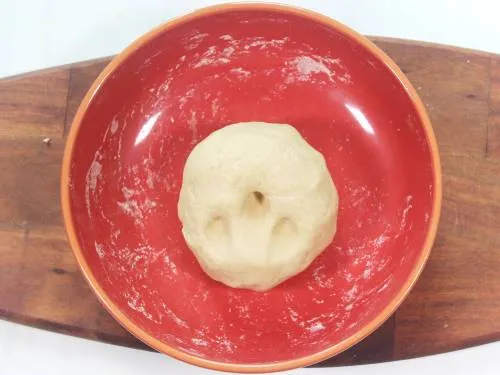
4. After 30 mins, knead the dough well until soft and pliable. If it is dry, wet your hand and knead. You can do this a few times as required. It can easily turn sticky if you splash water at this stage. So don’t.
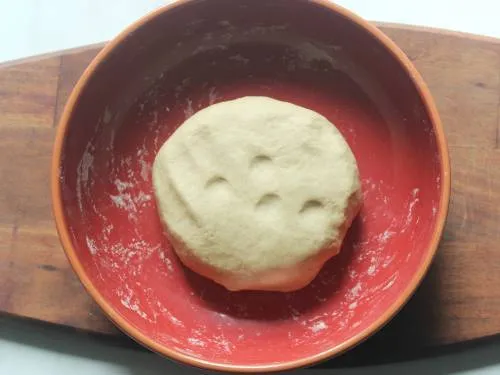
5. Divide the dough to 6 parts to make layered chapati. To make single layered, divide to 8 portions. Roll each ball in between your palms until smooth. Keep them covered until the end.
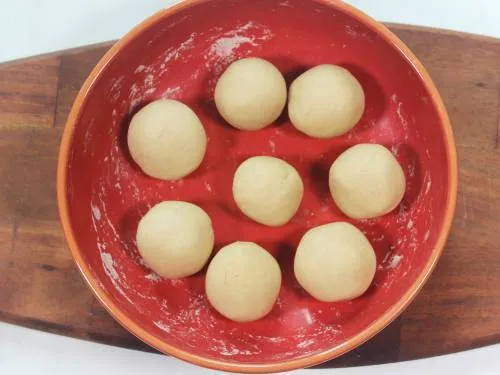
Rolling Single Layer Chapati
6. Flatten a dough ball and dip it in atta. Dust off the excess flour. Too much flour can make them hard.
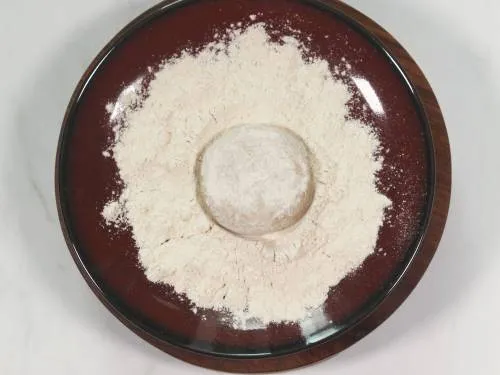
7. Start rolling on the clean kitchen counter or on a rolling board. After rolling 2 to 3 times, lift up the dough and rotate it a little in anti-clock wise direction. Roll it again 2 to 3 times.
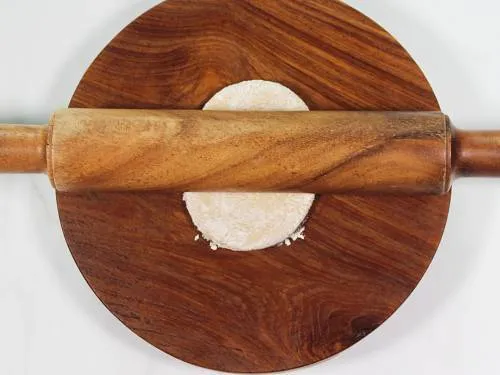
8. Roll lightly without putting too much pressure on the dough else it will get stuck at the bottom. Do not roll the chapati continuously, instead lift-up & rotate in clock-wise direction a little after every 3 to 5 rolls to ensure it does not get stuck to the board. As you roll, you may sprinkle little flour as required, if you feel it is about to stick. Roll it evenly all over, making sure you roll from one end to the other.
No Pressure, Even Rolling, Sprinkle flour only as required. If you want you may take a look at my Aloo Paratha Video, where I show the rolling part.
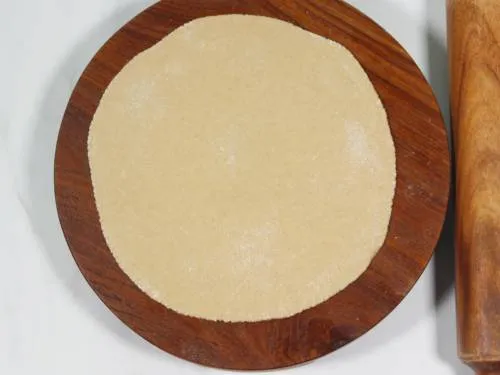
Cooking Chapati
9. Gently dust off each rolled chapati with your hand to remove excess flour, if any. Transfer them to a clean dry place on the counter, away from wind and heat. We don’t want them to dry out. You can roll about 3 to 4 and then start cooking, while you make the rest.
10. Heat a tawa/ pan (heavy bottom) on a medium high heat. When it is hot enough (not smoking hot), transfer the chapati to the pan. Within a few minutes, you will see bubbles over the chapati.
It is essential to regulate the heat when you are cooking the chapati. Too high will instantly burn them. Too low or even moderately low heat will make them hard and crispy/crusty. It is very important to cook them on a medium high heat, else they dry out.
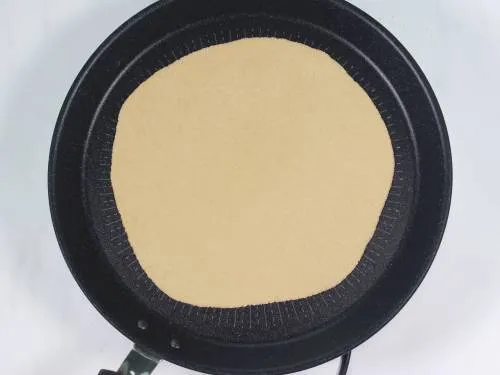
11. Quickly turn it to the other side & cook for a minute or 2. Spread little oil or ghee all over the chapati.
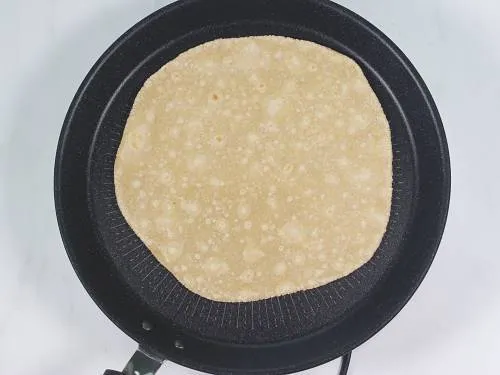
12. Turn it again to the other side, you will see it begins to puff up.
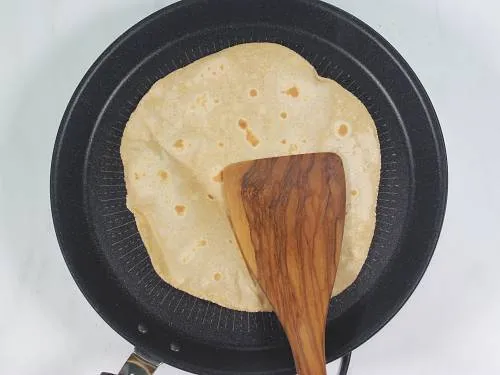
13. To make it puff evenly, press down with a wooden spatula in the places where it doesn’t puff. Do not use a sharp spatula, it can easily poke holes in them and prevent from puffing. Traditionally people use cloth or even bare hand.
Don’t worry if it doesn’t puff, it is not essential for a chapati to puff.
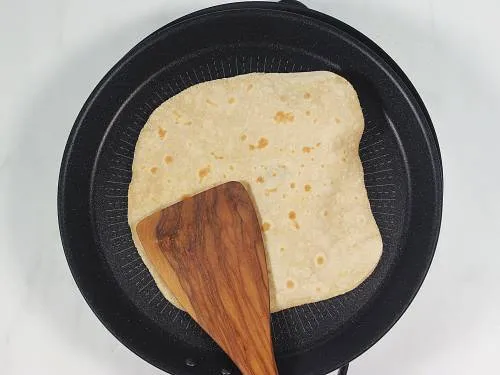
14. Spread a few drops or a spoon of ghee or oil on both the sides. You need to be quick at this stage. It is normal for the pan to smoke as soon as you add ghee.
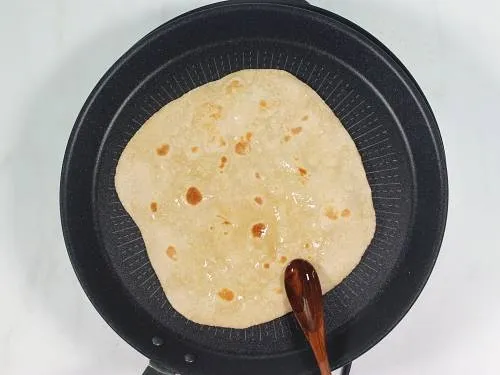
15. Cook for a few seconds or a minute to make sure your chapati is cooked all over, including the edges.
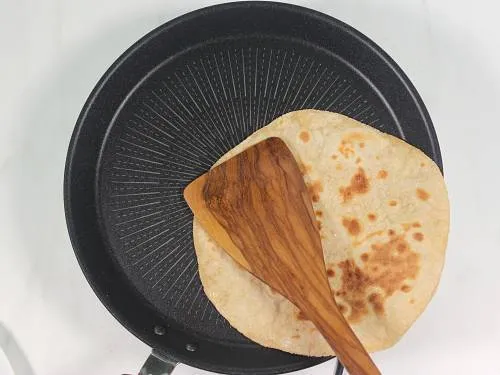
16. Remove to to a plate & stack.
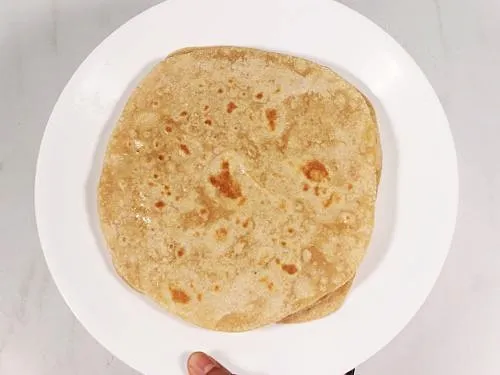
Rolling Layered Chapati
17. To make layered chapati. You will first roll it to a 4 to 5 inch disc. Smear a few drops of oil or melted ghee all over and sprinkle very little flour (2 pinches).
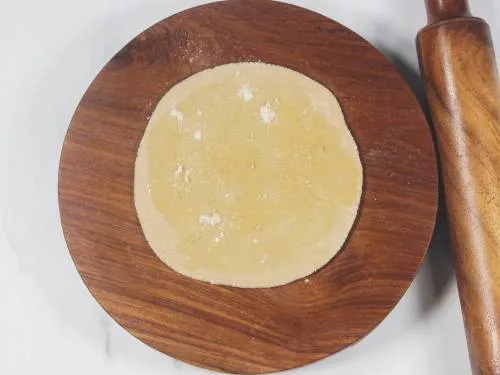
18. Fold it half way. Repeat the process of smearing ghee/oil and sprinkle flour.
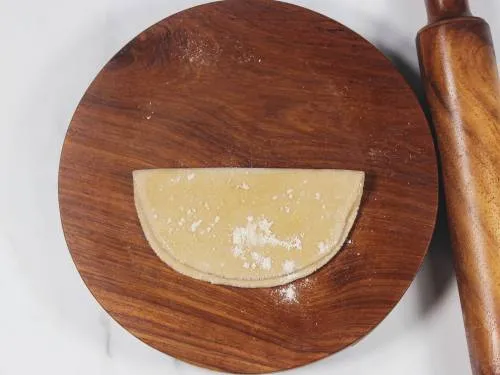
19. Fold it further. You get a triangle. Sprinkle little flour if required and begin to roll.
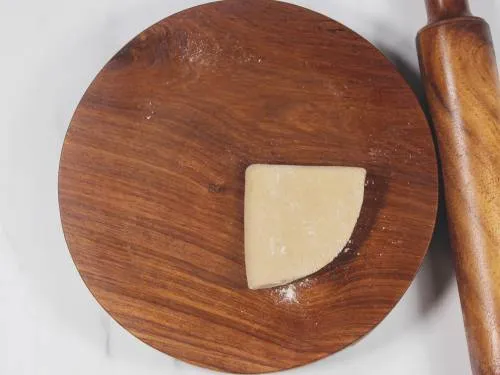
20. Roll it evenly to give a triangle /round or an imperfect round shape. Do not stress much on the shape but make sure you roll it evenly all over. Make the size according to the size of your pan. I roll mine in between 7 to 7.5 inches because I use a 10 inch pan.
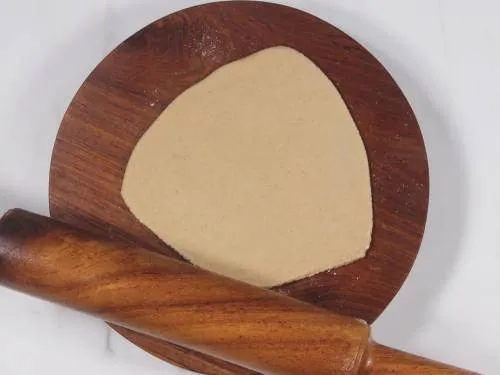
21. Heat a tawa or a pan on a medium heat. When it is hot enough, transfer the chapati.
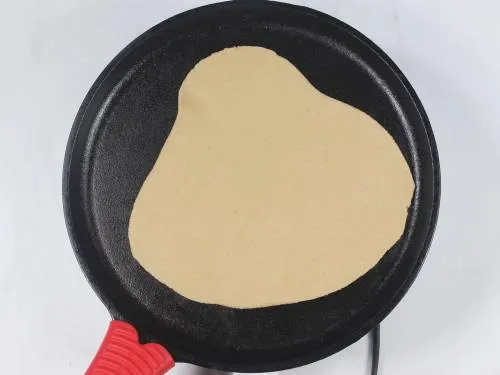
22. When you see bubbles, turn it to the other side and spread a few drops of oil or ghee. Cook pressing down lightly with a spatula. These will always puff because of the folding/layers.
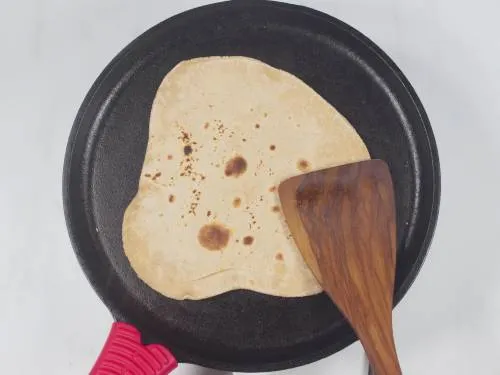
23. Spread more ghee and cook on both the side turning them too & fro for a few seconds or a minute. Make sure you cook them on the edges well.
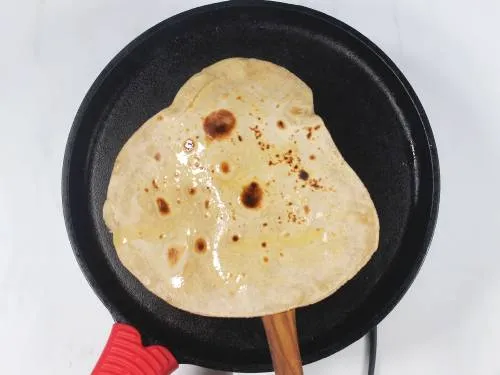
I stack them directly over a plate while cooking. If you want you may line the plate with a clean muslin cloth. Once done cooking, I fold them while still hot to retain the softness. Transfer to a container and place on a cooling rack. Loosely cover so they don’t sweat.
24. To make the next chapati, reduce the heat and wipe with a thick clean cloth or kitchen tissue & spatula. Be careful as the pan is really hot. You will be able to skip this step, if you dust off the excess flour well after rolling each chapati.
Serve chapati hot or warm with your favorite curry, dal or stew.
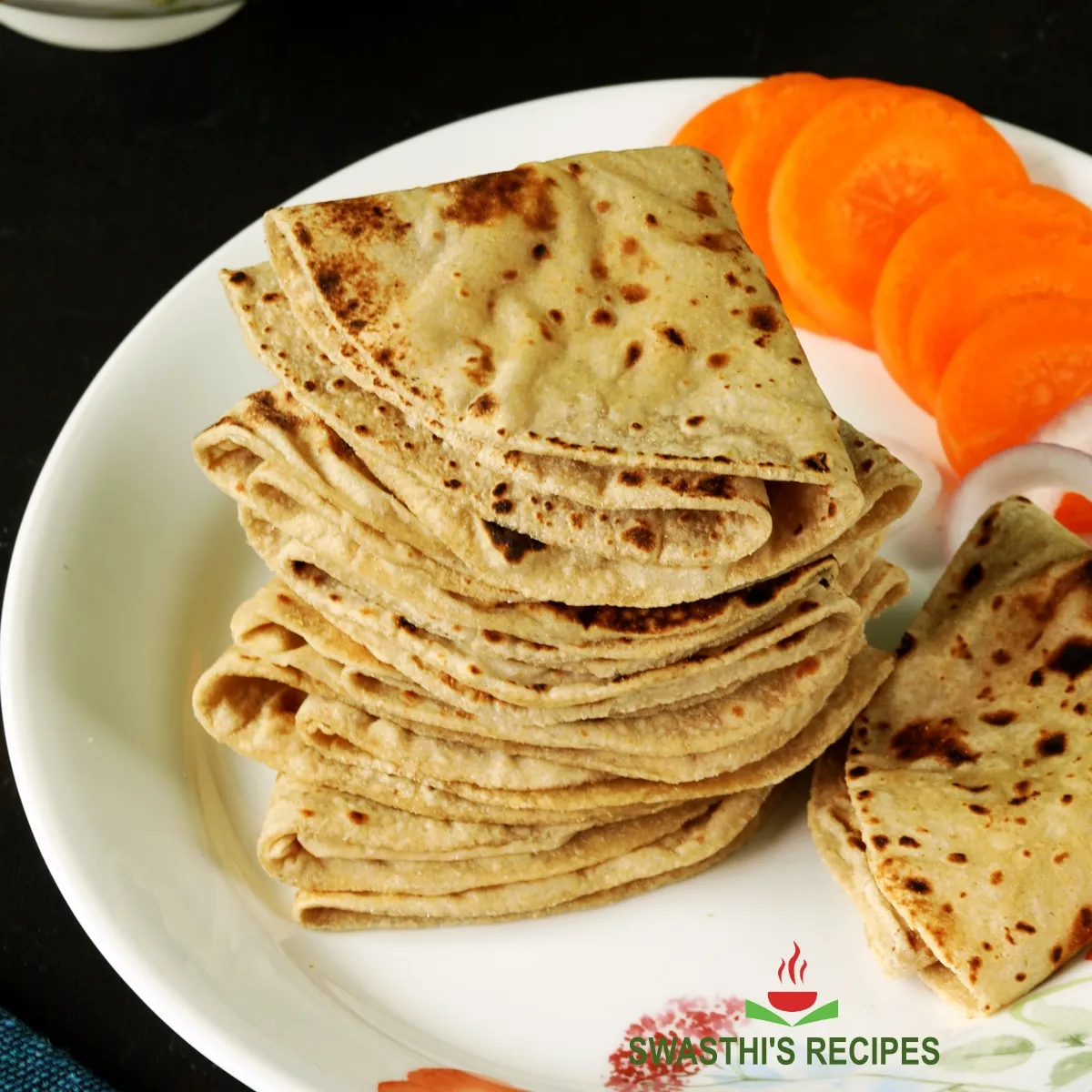
Pro Tips
Warm/ Hot water: Hot water works well for me, better than warm water. Hot water softens the bran in the atta so you get softer chapati. I use Chakki atta from Indian and Arab brands. So I am not sure if it works the same way with other brands. The water has to be hot but not boiling. I bring the water to a rolling boil and turn off. The temperature comes down slightly by the time I measure the flour.
Oil: I always use oil to make my dough. I feel it softens the bran, makes softer chapati & the dough is easier to roll.
Kneading Dough: I don’t knead the dough much before resting. I let it soak then knead well. If you want you can knead first and then rest. Never knead the dough without adding enough water. Kneading a dry dough will make hard flatbreads. Over kneading the dough can make hard chapati.
Choosing Atta: All chakki atta are not same. Experiment with different brands until you find one that gives you good results. You do everything right and still you get hard, rubbery and dry chapatis, then a lot of times it is due to the kind of wheat or the extra bran that is added to the atta.
Rolling Chapati: Making perfectly shaped chapati requires lots of practice which can be acquired only with consistent trials & practice.
Regulating heat: You can use a good quality non-stick or a cast iron tawa to cook your chapati. But regulating the heat is very important. You need to constantly keep adjusting the heat especially if using Cast iron pan.
Tawa/Pan: Please note that once you begin to cook your chapati in the tawa, it won’t work anymore to cook dosas. So always have one separately for all your flatbreads.
Related Recipes
Recipe Card
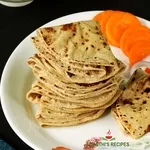
Chapati Recipe (Indian Flatbread)
For best results follow the step-by-step photos above the recipe card
Ingredients (US cup = 240ml )
- 2 cups chakki atta (stone ground whole wheat flour)
- ¾ cup warm water (or hot water, 2 to 4 tbsps more as required read notes)
- ¼ teaspoon salt (optional)
- 1 to 1½ tablespoons oil (optional, read notes)
- 2 to 2½ tablespoons ghee or oil
Instructions
Make Dough
- Add atta to a wide mixing bowl & make a well in the center. Add oil and salt if using. Pour warm or hot water and begin to mix. If using hot water use a spoon first and then your hand.
- Mix well to form a soft dough, splashing more water only as required. Knead the dough for a minute or 2. It has to be soft and not sticky or crumbly.
- Wet your hands and smear water all over the dough ball. Cover and rest for a minimum of 30 mins. You can leave up to 2 hours at room temperature.
How to Make Chapati
- When you are ready to make the chapati, knead the dough until soft and pliable. If the dough looks dry, moisten your palm and knead. It should not be sticky.
- Divide the dough to 6 portions to make layered chapati or to 8 portions to make single layer chapati. Gently roll the balls in between your palms to smoothen them. Cover until you use up.
- Slightly flatten a ball and dip in flour to coat it with flour all over. Shake it gently to dust off the excess flour.
- Begin to roll the dough evenly without putting pressure. After 2 to 3 rolls, lift it and move it in clock-wise direction a little. Continue to roll it and then move it in clock-wise direction. If the dough begins to stick to the rolling pin or to the kitchen counter, sprinkle little flour. (not too much)
- Single Layer Chapati: Repeat these steps until you make a 7 to 8 inch chapati.
- Layered Chapati: After rolling the dough to 4 to 5 inches disc, smear melted ghee or a few drops of oil and then sprinkle 2 pinches of flour. Fold it to half, to make a half circle. Smear oil and flour and fold again to make a triangle. (Check the pictures). Sprinkle a bit of flour and roll to a 7 inch chapati.
- After rolling the chapati, take it to one of your hands & dust the excess flour with the other hand. Transfer to a dry place, away from wind and heat. After rolling 3 to 4 begin to cook.
Cook Chapati
- Heat a tawa/ pan on a medium high heat. It should be hot enough but not smoking.
- Gently transfer the chapati to the hot tawa and wait until you see a few bubbles. Using a spatula, turn it to the other side. Spread little oil or ghee all over the chapati. Let cook for a minute or 2. (If required regulate the flame to medium. This depends on the kind of stove & pan.)
- Turn back to the other side. It will ideally begin to puff. Press down with a spatula gently in place where it doesn't puff up. This helps the chapati to cook and puff. Keep rotating it and cook on the edges too.
- Spread some ghee or oil all over and turn it to the other side. Spread ghee here as well. You will begin to see some smoke from the pan. It is normal. Remove to a plate.
- Before cooking the next chapati, reduce the heat and wipe your tawa with a thick clean cloth or tissues. Be careful while you do this. To avoid this step, make sure you dust off the excess flour from the chapati after rolling.
- Stack the hot chapatis on a plate. Once done cooking all of them, fold each to a triangle, while still hot. Transfer to a container & place over a cooling rack. Cover partially so they don't sweat. This keep them soft.
- Serve chapati with curries, stew, dal or use them to make wraps, rolls etc.
Notes
- If you are in India, use warm water to make the dough. I use hot water, not boiling hot.
- Oil makes the dough softer & makes rolling easier. I use 1½ tablespoons for 2 cups atta. While this is optional, you may try out both the ways to check the difference.
- The amount of water to use depends on the kind of flour. Some soak up more, while some don’t.
NUTRITION INFO (estimation only)
© Swasthi’s Recipes
About Swasthi
I’m Swasthi Shreekanth, the recipe developer, food photographer & food writer behind Swasthi’s Recipes. My aim is to help you cook great Indian food with my time-tested recipes. After 2 decades of experience in practical Indian cooking I started this blog to help people cook better & more often at home. Whether you are a novice or an experienced cook I am sure Swasthi’s Recipes will assist you to enhance your cooking skills. More about me
Follow Swasthi’s Recipes

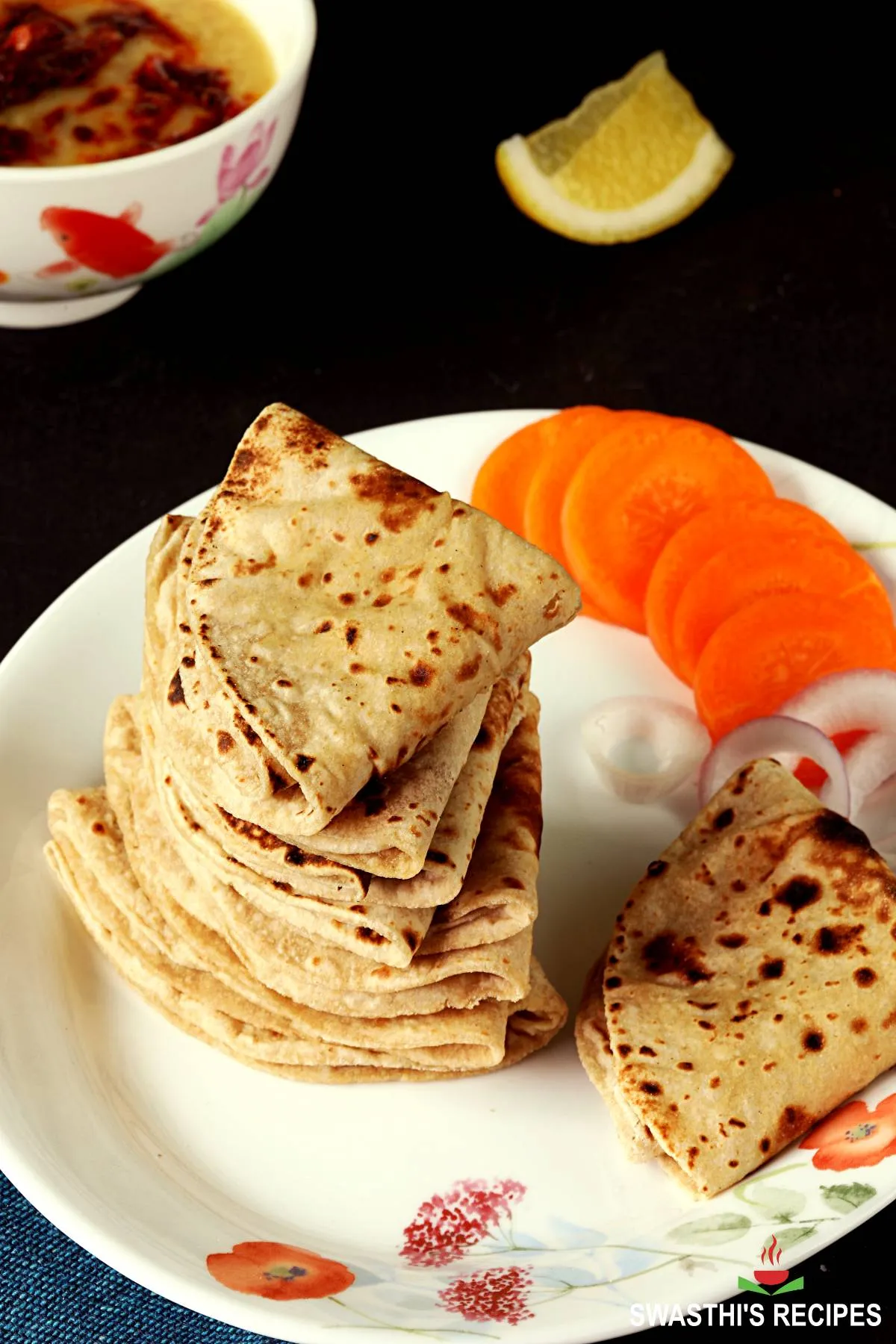
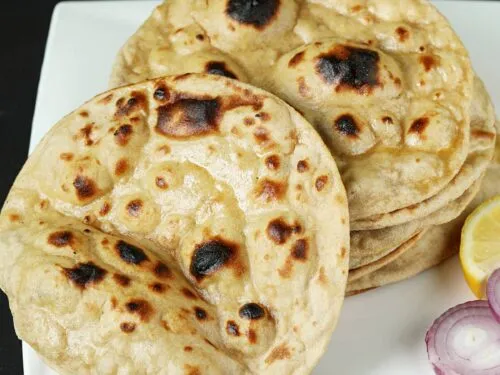
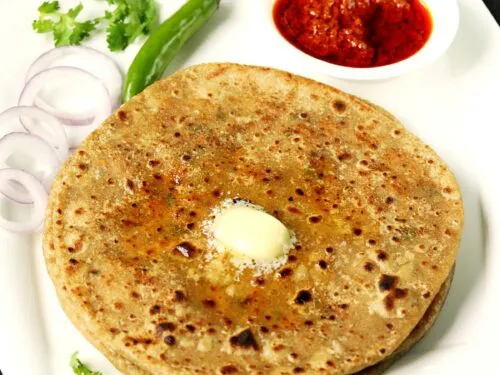
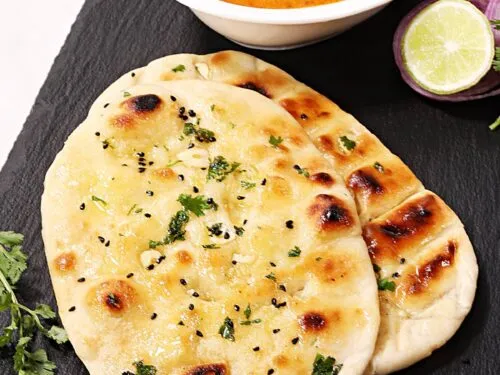
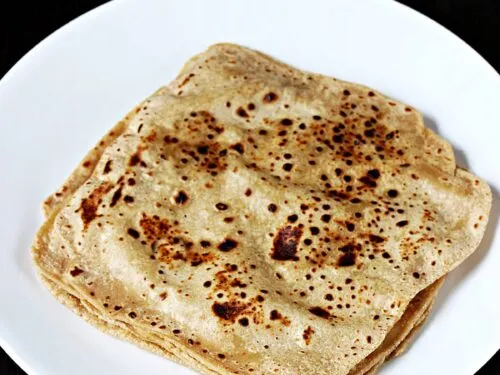
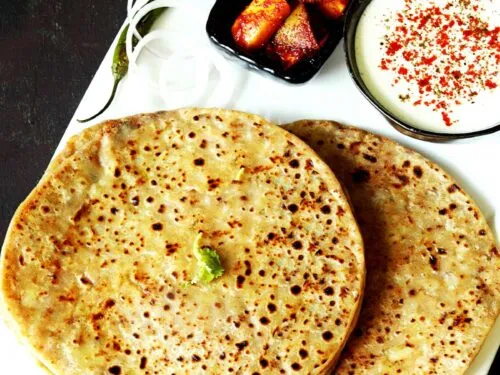
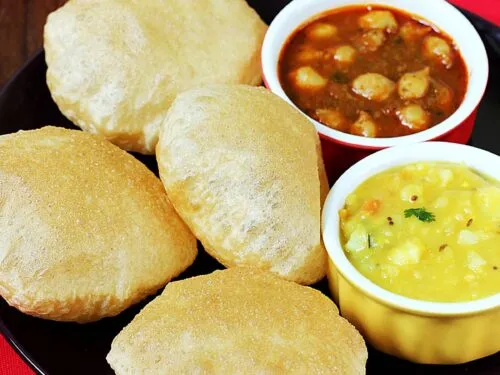
Comments
For the first time, my chapatis came out really well !
Glad to know Najwa. Thank you for sharing back
Thank you so much for your sharing.
Can I use bread flour or all purpose flour since I don’t have wheat flour at the present?
Yes you can use.
Thankyou for your recipes. can you tell me what type of tawa pan you use. Can’t wait to try your recipes.
Hi Deborah,
I use a lodge bare cast iron pan but in the pictures I have used a Tefal titanium pro non-stick pan. Not all non-sticks are good for toasting chapati or roti. Some don’t cook well. Cast iron or iron pans are best. You can take a look at my cast iron pan in this kathi rolls recipe. I also use hawkins futura hard anodised roti tava. I love this one but it is hard to cleanup
Thank you for sharing so many good recipes and cooking videos that were easy to use at my home.
Glad to know Chan. Thank you
Thank you for these directions. I have often seen chapati transferred to a second (hotter?) surface for the final “puff”- why is that done?
Hi Kathy,
Chapati is never cooked on a second surface. It is cooked and finished on a tawa/ pan. A roti is often puffed on fire or over a rack placed on direct fire. Chapati and roti are different
Thank you very much I love your teaching this is powerful
Glad you like it
Thank you for this recipe!
How long can freshly made chapatis keep warm in Indian stainless steel box? I am thinking of making some for a dinner of 12 people and I will need to make them a little in advance. I dont use a microwave, so any tricks with that won’t be possible. Thank you for your help.
Hi Farah,
I would suggest storing them in the refrigerator and reheating in a Instant pot if you have one. This way you can also make them 2 to 3 days ahead. This method keeps my chapatis very soft. Alternately you may wrap them in a cotton cloth and then in a foil. Keep them in a preheated oven at 60 C/ 140 F. Hope this helps.
Nice recipe. Can I add ground flaxseeds to the atta? How much would you recommend in this recipe? I am looking forward to making these soon.
Thanks Dee. You can add 3 to 4 tablespoons ground flaxseeds per 2 cups atta. Adding more will alter the flavor and texture of chapatis. Hope you like them.
Hot water trick seems to have worked well for me. My chapatis turned out good but guess I need more practice. Do you think my induction stovetop is the problem?
It is not that you won’t be able to make good chapati on induction but you need more practice cooking them. Also the portable induction stove won’t work well but the results are different with induction stovetop and it also depends on how powerful it is. I guess more practice helps. Also it could be your tawa. Non-stick won’t make good chapatis, unless you make them layered. Hope these help
Hi Swasthi, how thin do you roll the chapatis? I intend to make some later this week, as this looks like the perfect recipe
Hi alan,
that’s a really difficult question to answer. It is not paper thin and not thick like a naan. You make 1 to 2 first, toast them and then see how they turn out. Too thin, they won’t puff and may turn like papads (hard). Too thick they remain doughy & won’t cook inside. You will get better after making a few batches. Hope this helps. I would be happy to help you further if you are unable to make them right
Can i use stand mixer
yes you can
I tried making chapati following both the methods. To achieve better results use the folding method. That gives pretty good results at the first attempt. I was shocked to see my chapati were so soft and well cooked. I also learnt from this post dry heat on your griddle is going to harden the chapatis. Use more oil or ghee and you get the perfect chapatis. Thank you.
Glad your chapati turned out good. You are right for beginners the layered method yields better results because some of the steam is trapped in the layers and this keeps them soft. Making the non-layered chapati requires practice but they are very fast to make. Thank you for sharing your experience
Thanks for inspiring me with the step by step pictures. It took me 3 trails to get the chapati right. I have to work on my rolling skills because they are not perfectly round.
Yes making prefect chapati require a little practice. Thanks Grishma
Just made Chapati. This is a very nice and very easy recipe.
I had to adjust the temperature until it was right and the Chapati came out perfect.
Very soft and very tasty.
Thank you.
Glad to know Peter. Thank you so much for sharing back
I noticed you don’t have baking powder in the recipe does it still rise
Baking powder is never used in chapati, roti and paratha recipes
So, I made chapati for the first time ever, and here’s what happened. I used a seasoned cast-iron griddle, and the first chapati came out perfect: beautifully puffed, soft, everything. The second one puffed less, the third one even less, and by the time I got to number 5, it was flat and hard like a cracker. The one step I skipped was spreading the chapati with oil towards the end of cooking, and I’m thinking this must be the reason. The griddle had some oil residue when I started, but it wore away and became increasingly dryer. I’ll try again, adding the oil, but would be curious to know if you think this was the problem!
Hi Jennifer,
Since the first chapati came out good, it means the dough was perfect. They turn out hard due to lesser heat (griddle not hot enough) and longer cooking. Make sure the griddle is hot enough but not super hot. Try adding oil immediately after turning them the first time. While cooking them on cast iron I always use more oil. It is not recommended to use cast iron without fats. Dry heat can actually damage it. Hope this helps.
Hi Swasthi–thanks, and I think you must be right about using more oil with cast iron. I had some dough left over from that batch and made the last two chapati as a late-night snack. I put more oil on the griddle and brushed the chapati with butter while they were cooking, and they came out nice and soft. I’m pretty sure it was the oil and not the heat, because the first batch got progressively harder no matter how I adjusted the heat. It’s interesting, because I’d looked at several recipes online before I went with yours, and some of the others say nothing about using oil/ghee during cooking, just brushing with ghee after cooking. So I didn’t think it was important, but it turns out to be VERY important. Anyway, thanks for the great recipe: a neighbour gifted me 9 kg of atta they bought by mistake, so I had to learn to make chapati!
Good to hear from you Jennifer! Just want to let you know: When I shot the pictures for this post, I had to use lesser oil & also used it a bit later because it was smoking up a lot that my camera was unable to shoot with all the smoke.
Up until now, making a round chappati is like a blue moon! It is every other shape but round. Thanks for educating me on the difference between roti and chappati. I will try to make it today with your tips.
Hehe! That happens with a lot of us, even with experienced people because if we stop making them for some time we are beginners again. People who learn rolling chapati/roti at a very young age (6 to 10) are best at it. Thanks for reading Hema!
Your pics and description of what next to do is fantastic and really helpful. I’m still learning to perfection making chapatis and this article helped me. Thank you
I tried your chapati recipe and they turned out so good in the first try. Thank you for the easy instructions.
Thank you Emily for trying and sharing how they turned out for you.
Hey there – thanks so much for this! Hope you are well. Cindy
Hi Cindy,
Yes doing good! I really took so long to share this recipe. Sorry to keep you waiting!
🙂